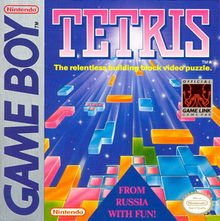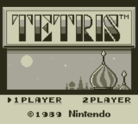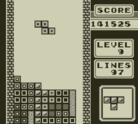Tetris (Game Boy): Difference between revisions
No edit summary |
No edit summary |
||
| Line 1: | Line 1: | ||
{{Infobox |title = Tetris | {{Infobox |title = Tetris | ||
|developer = [[ | |developer = [[Nintendo]]<br>[[Bullet Proof Software]] | ||
|publisher = [[Nintendo]] | |publisher = [[Nintendo]] | ||
|released = {{Release|JP|June 14, 1989}}{{Release|US|July 31, 1989}}{{Release|EU|September 28, 1990}} | |released = {{Release|JP|June 14, 1989}}{{Release|US|July 31, 1989}}{{Release|EU|September 28, 1990}} | ||
Revision as of 05:39, 3 August 2019
| Tetris | |
|---|---|
 Cover for North American standalone release of Tetris | |
| Developer(s) | Nintendo Bullet Proof Software |
| Publisher(s) | Nintendo |
| Platform(s) | Game Boy |
| Release |
|
| Gameplay info | |
| Next pieces | 1 |
| Playfield size | 10 × 18 |
| Hold piece | No |
| Hard drop | No |
| Rotation system | Nintendo Rotation System, left-handed |
Tetris (テトリス Tetorisu) was released for the Game Boy in 1989. In North America and Europe it was bundled with the Game Boy, and later on sold as a stand alone game. It is the first game to make use of the Game Boy's Link Cable, an accessory that allows two Game Boys to connect to each other. On December 2011, a 3DS Virtual Console version was released, without multiplayer functionality, and was subsequently delisted from the Nintendo eShop on December 31, 2014.
A color remake, Tetris DX, was released for the Game Boy and Game Boy Color in 1998, featuring new modes, color, and new rotation system.
This was the first widely distributed Tetris game to feature 2-player battles with garbage using the Link Cable.
Gameplay
In Marathon (called A-TYPE), when the player line clear (startLevel * 10 + 10), the level advances by 1. After this, the level advances by 1 for every 10 lines.
The "heart levels" (activated by holding Down+Start at the title screen) are as fast as the level plus 10, but unlike on the NES version, they don't improve the score.
The scoring is based on that of the BPS games but with a level multiplier incorporated, detailed here. The same system would be used in several other Tetris games with minor variations. The maximum score is 999,999.
Timings
The Game Boy runs at 59.73 frames per second.
- Soft drop: 1/3G
- ARE: 2 frames (tetromino is invisible for first frame after it spawns)
- ARE+line clear: 93 frames
- DAS: 24 frames (1/9G)
| Level | Frames per row |
|---|---|
| 0 | 53 |
| 1 | 49 |
| 2 | 45 |
| 3 | 41 |
| 4 | 37 |
| 5 | 33 |
| 6 | 28 |
| 7 | 22 |
| 8 | 17 |
| 9 | 11 |
| 10 | 10 |
| 11 | 9 |
| 12 | 8 |
| 13 | 7 |
| 14 | 6 |
| 15 | 6 |
| 16 | 5 |
| 17 | 5 |
| 18 | 4 |
| 19 | 4 |
| 20 | 3 |
This table is located at 1B06h in the ROM; each entry is one less than the actual number of frames. For example, level 1, or 49 = 31h frames, is stored as 30h.
2 Player
2 Player mode is a garbage-based battle mode played using the Link Cable. Before starting each player can configure their starting height. Garbage is single aligned hole (same for both players) and based on a system that sends 1 line on a double, 2 lines on a triple and 4 lines on a Tetris. In addition, if a player clears 30 lines then they win the round automatically.
Both players have the same piece sequence, same starting garbage and same garbage hole. First to 4 rounds wins the match.
Development
Nintendo, through the help of Henk Rogers, purchased the license from Elorg to package it with every new Game Boy system. (An exception was Japan, where the system did not come bundled with any games.) Because of this, many players of the Game Boy generation remain familiar to this title, as it probably sold more than any other Tetris title so far. Having Tetris packaged with Game Boy may likewise have had something to do with Game Boy's success.
External links
- TAS of B-Type, including a discussion of several mechanics quirks (including top out condition and bugs)
- The Cutting Room Floor page describing version differences
| ||||||||||||||

